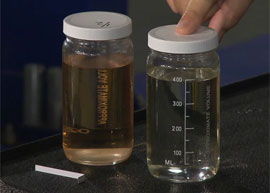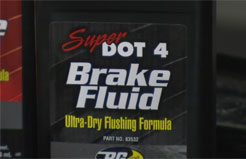Brake Fluid Basics
In the sixty years since this car was leading edge technology, just about every part of every car on the road has changed immensely. But there is one thing that has remained, well, almost the same. And that's brake fluid.
 Brake fluid has always had a propensity to absorb moisture, and that meant that it could deteriorate parts in the brake system. But today that means a bigger and more expensive problem. See, if you look at these two containers of brake fluid, this one is pure brake fluid, this one is fifty percent water. Half of it is water. Well, yea it looks a little bit different, but it certainly isn't the sort of thing that you think could endanger an expensive part of the car, or even your life for that matter. But it could. And that means that you have to check the condition of the brake fluid a couple times a year.
Brake fluid has always had a propensity to absorb moisture, and that meant that it could deteriorate parts in the brake system. But today that means a bigger and more expensive problem. See, if you look at these two containers of brake fluid, this one is pure brake fluid, this one is fifty percent water. Half of it is water. Well, yea it looks a little bit different, but it certainly isn't the sort of thing that you think could endanger an expensive part of the car, or even your life for that matter. But it could. And that means that you have to check the condition of the brake fluid a couple times a year.
You want your technician to use a brake fluid test strip, such as we have down here. Now that will tell if there is a lot of water in the brake system. But once you have found out that there is water in the brake system, that means that it has to be flushed. And by the way, never go more than two years without flushing a brake system, no matter what the circumstances.
 Alright, so now we're going to flush it. First thing we have to do, we have to look at the cap on the master cylinder, or the owner's manual, to see what fluid goes into that brake system. Alright, now, for years we've had DOT 3 and DOT 4, and we've had DOT 5. Well now there is a new player, and that's Super DOT 4. Alright, now, here's the rule: DOT 5 is usually not used in cars with ABS or Traction Control. So we forget about that. Then, read the cap, or the owner's manual, find out if your car need DOT 3, DOT 4, or Super DOT 4, and make sure you use the proper fluid. Now, this Super DOT 4 is also used in a lot of hydraulic clutches on cars, because it can withstand more heat. So, more complication, but just read the directions. And if you have a question or comment, drop me a line, right here at MotorWeek.
Alright, so now we're going to flush it. First thing we have to do, we have to look at the cap on the master cylinder, or the owner's manual, to see what fluid goes into that brake system. Alright, now, for years we've had DOT 3 and DOT 4, and we've had DOT 5. Well now there is a new player, and that's Super DOT 4. Alright, now, here's the rule: DOT 5 is usually not used in cars with ABS or Traction Control. So we forget about that. Then, read the cap, or the owner's manual, find out if your car need DOT 3, DOT 4, or Super DOT 4, and make sure you use the proper fluid. Now, this Super DOT 4 is also used in a lot of hydraulic clutches on cars, because it can withstand more heat. So, more complication, but just read the directions. And if you have a question or comment, drop me a line, right here at MotorWeek.





